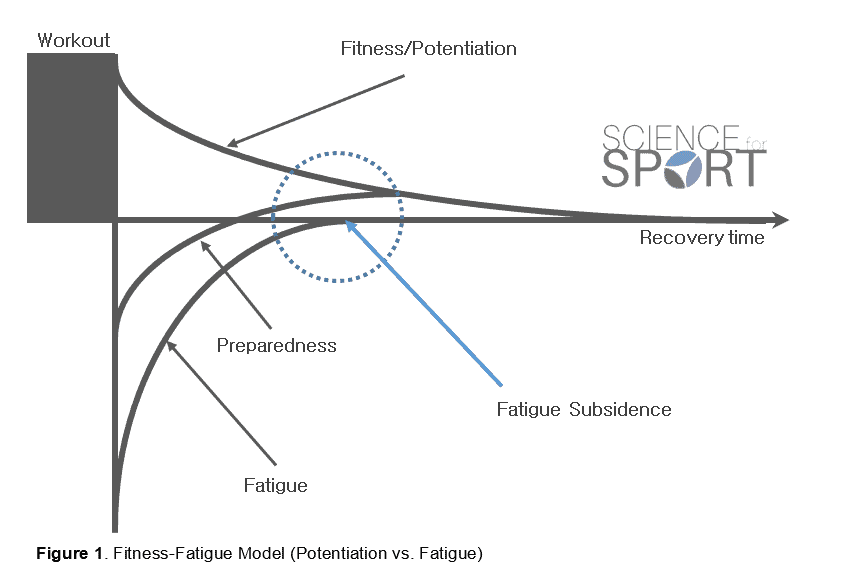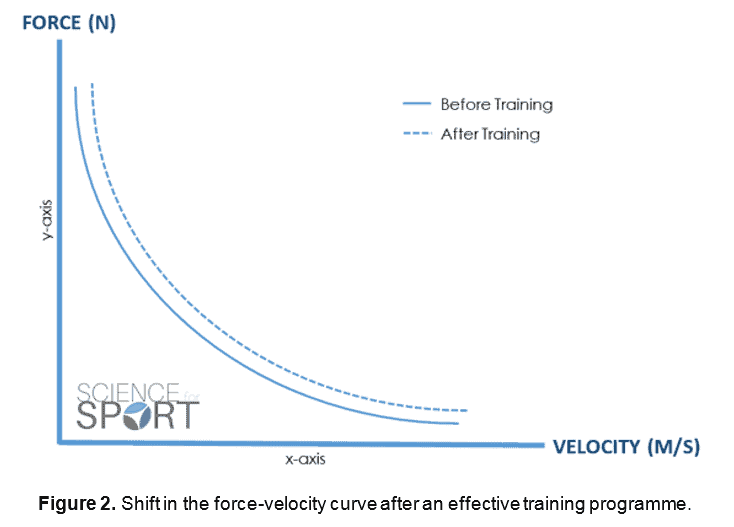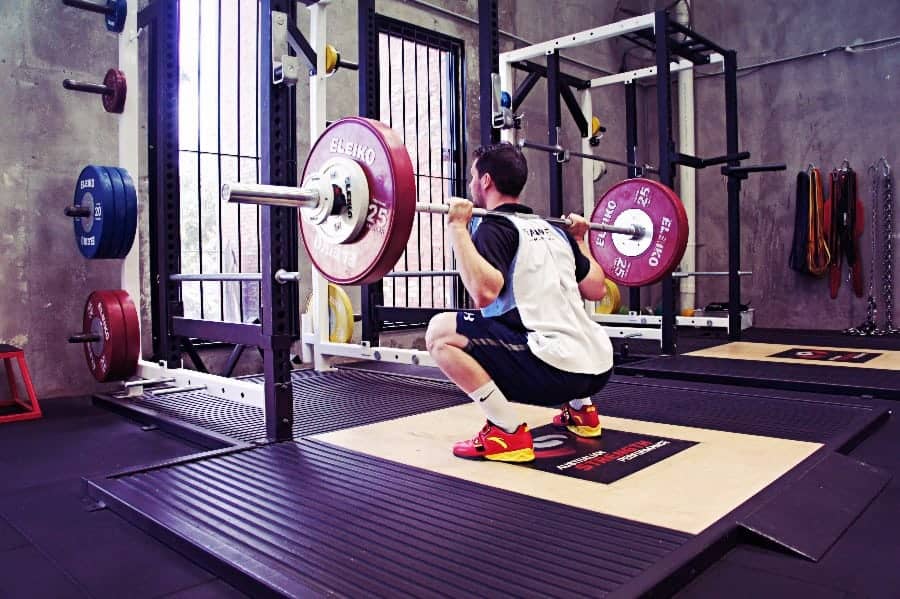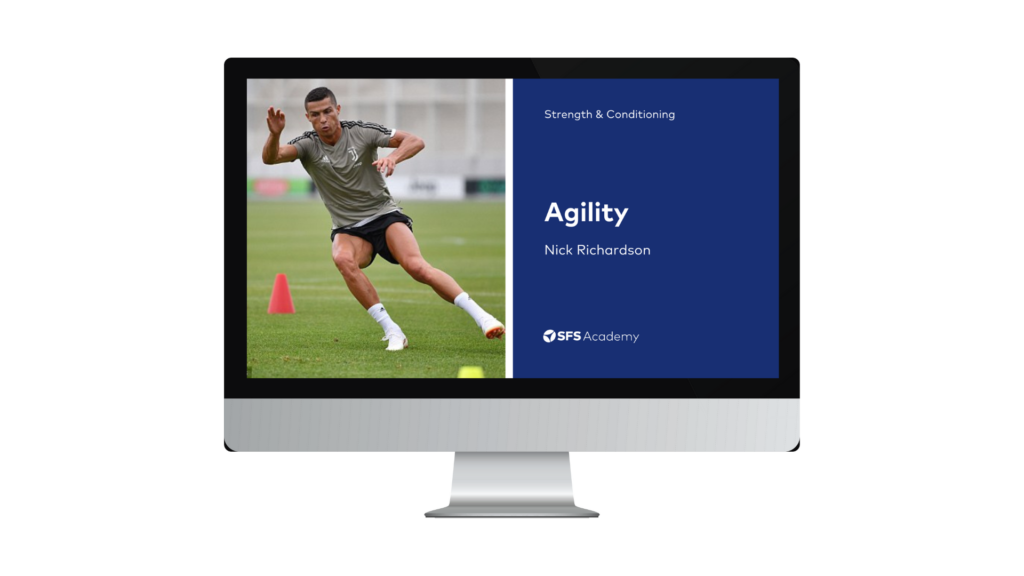Contents of Article
- Summary
- What is post-activation potentiation (PAP)?
- What is the fitness-fatigue model?
- How does rest time impact post-activation potentiation (PAP)?
- What causes post-activation potentiation?
- What intensity is best for creating post-activation potentiation?
- Should I use post-activation potentiation or not?
- Conclusion
- References
- About the Author
Summary
Post-activation potentiation (PAP) refers to a short-term improvement in performance (e.g. jumping) as a result of using a conditioning exercise (e.g. back squats). Many conditioning exercises, for example back squats, deadlifts, plyometrics and isometric contractions have all been shown to improve subsequent performances. This performance improvement is due to the muscles being placed into a ‘potentiated’, or ‘activated’ state.
At present, there is no common agreement on what causes the muscles to experience this ‘potentiated’ state, though several neurophysiological mechanisms have been suggested – with some bearing more evidence than others.
Furthermore, no scientific review has thoroughly attempted to identify an optimal rest time between the conditioning exercise and performance exercise, as a result perhaps durations between 3-12 minutes are most effective. The use of heavy-load exercises (> 80 %) appears to be more effective for causing a potentiated state than light-loads or even plyometrics.
Lastly, it is important to understand that the effects of PAP are highly individualised, and therefore training should be specifically designed for each athlete to maximise results.

What is post-activation potentiation (PAP)?
Post-activation potentiation (PAP) simply refers to an acute excitation of the neuromuscular system following some form of exercise (e.g. 5RM back squat). This acute excitation has been shown to improve subsequent explosive performances such as the countermovement jump (CMJ) and sprint speed (2, 3). So effectively, by performing a five-repetition maximum (5RM) back squat several minutes before performing an explosive exercise (e.g. CMJ or sprint), you could improve your performance. Interestingly, this training method has been shown to improve jumping (2), sprinting (4), throwing (5), kicking (6), and even change of direction speed performances (6).
It must be noted that the conditioning exercise must be biomechanically similar to the performance activity. For instance, a back squat can be used to improve a CMJ because they have biomechanical similarities. However, a back squat may not improve throw performance because the exercises are not biomechanically similar.
Although most research investigating this phenomenon has emerged in the past decade (7), this method of training can actually be traced back to the mid-20th century (1). Throughout its time, PAP has also been referred to as post-tetanic potentiation, post-tetanic facilitation, complex training, strength-power potentiation complexes, or complex pairs.
What is the fitness-fatigue model?
It is very well-documented that PAP can improve subsequent performance, and exercises such as heavy back squats have repeatedly proven their effectiveness in doing so (8, 9). For example, improvements in vertical jump performances have been reported several minutes after the completion of heavy back squats (9). However, it has been made clear that a significant amount of recovery must be administered between completing the conditioning exercise (e.g. heavy back squats) and the performance exercise (e.g. CMJ or sprint). If not enough rest time is provided, then there may be no performance improvement at all (5).
This is often the result of fatigue, which still lingers from the previous conditioning exercise (e.g. heavy back squats). If too much rest is provided then the potentiation may dissipate, also causing no improvement in performance (10). So interestingly, the effects of PAP are often viewed as a ‘window of opportunity’, or as the ‘Goldilocks Principle’ – too little rest, fatigue still lingers, so no performance improvement is seen; too much rest, the potentiation dissipates, and again no performance improvement is seen. But just enough rest and performance improvement is observed.
This concept has been termed as the ‘fitness-fatigue model’ and is demonstrated in Figure 1. It is at the moment that the fatigue dissipates that the effects of PAP can be utilised.

In an inimitable study, it was observed that this fatigue develops either centrally or peripherally to the central nervous system depending upon the type of conditioning exercise (i.e. isometric or dynamic contraction) (11). However, this effect is still not fully understood and further research into this topic is required so that exercise professionals can create more effective training programmes which utilise the effects of PAP.
How does rest time impact post-activation potentiation (PAP)?
Whilst conditioning exercises have been shown to potentiate the neuromuscular system, they are also shown to induce a level of fatigue – formerly explained by the fitness-fatigue model. These effects have been widely reported in large quantities of research (10). For example, one study reported an initial decrease in performance immediately after the conditioning exercise but then witnessed significant increase after 4.5-12.5 minutes of recovery (12). The authors reported that this initial decrease in performance was associated with fatigue. Again, the fitness-fatigue principle then suggests that after the 12.5-minute rest time, the performance ‘normalises’ as the potentiation subsides back to where it was before the conditioning contraction.
Therefore the duration of the rest time is essential to the effects of PAP in order to prevent any effects of the potentiation being masked by fatigue. Thus, an optimal balance between rest time and potentiation must be established (10). Though many studies have directly investigated varying rest times to identify which duration is most effective (4, 13, 14), there has been no uniform agreement amongst researchers.
To make things even more difficult, no research reviews on PAP have been able to establish an appropriate rest time (10, 15, 16, 17, 18), though one by DeRenne suggested between 8-12 minutes (19). This constant difficulty to isolate an optimal rest time is simply due to the variability of athletes (individuality – i.e. everybody is different principle).
It is well-understood that optimal rest times differ between different populations. Trained athletes have been shown to be more sensitive to the effects of PAP than untrained individuals (20). Individuals with higher strength levels have also been observed to possess a higher sensitivity to PAP than weaker individuals (5, 21). Likewise, individuals with higher power-strength ratios have also been shown to be more sensitive to the effects of PAP than their weaker counterparts (22). Understanding your group of athletes is imperative if you are to maximise the effects of PAP.
Moreover, the type, intensity, and volume of the conditioning exercise can also impact the magnitude of the potentiation because all these factors can influence the amount of fatigue. This makes providing accurate training guidelines very difficult and also complicates the decision of the strength and conditioning coach when designing the training programme.
Though the one review by DeRenne (2010) (19) has suggested rest times between 8-12 minutes, there is a large body of research that has shown performance improvements from 3-12 minutes (2, 4, 12, 13, 20, 21, 23, 24, 25, 26, 27). However, it is important to note that this only represents a margin of the research, as there is an enormous amount of research conducted on PAP. Regardless, it may be suggested that rest times between 3-12 minutes may be most effective for utilising the effects of PAP.
In summary, the rest time is highly dependent upon the conditioning exercise and training status of the athlete (e.g. trained or untrained), and should therefore be tailored specifically for the individual in hand. As a consequence, exercise professionals typically work by using the rough guidelines below:
- 3-12 minutes rest
- High intensity/ heavy-load (e.g. 90%RM) = longer rest time
- Low intensity/ light-load (e.g. 30%RM squat jumps/ plyometrics) = shorter rest time
- Higher volume sets = longer rest time
- Lower volume sets = shorter rest time
- Trained athletes = shorter rest time
- Untrained athletes = longer rest time
- Stronger athletes = shorter rest time
- Weaker athletes = longer rest time
What causes post-activation potentiation?
The underlying mechanism responsible for PAP is a combination of several neurophysiological responses both intra- and inter-muscular. Though there appears to be multiple neurophysiological mechanisms that may contribute to the effects of PAP, there are three in particular which are thought to provide the largest effects (10).\:
- Phosphorylation of the regulatory light chains
- Potentiated H-reflex response
- Pennation angle of the muscle fibres
Phosphorylation of the regulatory light chains
The first theory suggests that after the conditioning exercise, there is an increase in the phosphorylation of the myosin regulatory light chains (RLC) (10). This increases the sensitivity of the myosin-actin interactions, which may lead to an increase in the cross-bridge cycling rate (28). This alteration could ultimately result in a shift in the force-velocity curve to the right, allowing faster movements with higher loads (15) (Figure 2).

Positive correlations between increases in RLC phosphorylation and potentiation have been reported in many animal studies (29, 30), but very few studies have been conducted on human subjects (10). Of the research conducted on human subjects, numerous have found no significant RLC phosphorylation (31, 32). Whilst a correlation between RLC phosphorylation and potentiation is evident in animal studies, there appears to be an inconsistency in the research on humans. This suggests that other factors may be responsible for inducing PAP in humans.
An interesting finding regarding the RLC phosphorylation theory, is type II muscle fibres appear to experience greater phosphorylation than type I muscle fibres (33). This suggests individuals with a higher percentage of type II fibres, such as strength and power athletes, may experience a greater potentiation (10). However, this would potentially only apply if the phosphorylation theory is correct.
Potentiated H-reflex response
The second theory thought to be responsible for PAP is an excitation of several neurological mechanisms following a conditioning exercise. There are several neural responses suggested to experience a state of excitation following a conditioning exercise, such as H-reflex potentiation, an increase in motor unit synchronisation, desensitisation of alpha motor neuron input, and a decrease in the reciprocal inhibition of the antagonistic muscles (34). However, H-reflex potentiation appears to be the most dominant neural mechanism found within the research (35, 36, 10). The H-reflex is an electromyographic (EMG) measurement of the level of excitability of a muscle. Quite simply, higher H-reflexes are associated with higher excitability.
The H-reflex is the result of an afferent neural volley in response to single-pulse sub-maximal stimulation of the relevant nerve bundle. With sufficient recovery, PAP increases H-reflex amplitude; this is thought to be due to increased recruitment of high-order motor neurons at the spinal cord (10). An increased recruitment of high-order motor neurons would, therefore, lead to a faster and more forceful muscle contraction, resulting in improved performance.
Pennation angle of the muscle fibres
In recent years, a third theory appears to be arising within the literature (37). This theory suggests there is a decrease in the pennation angle of the muscle fibres following a conditioning exercise. A decrease in the pennation angle of the muscle means more force can be transmitted through the tendon and ultimately to the bone upon contraction – a more forceful contraction means a better performance (36). However, there is little research supporting this theory, therefore more research is warranted before more accurate assumptions can be made (10).
What intensity is best for creating post-activation potentiation?
Currently, there is a lot of conflict within the research regarding which exercise intensity is best for inducing PAP (10). For example, whether a back squat at 60 % of one repetition maximum (1RM) is better than using a back squat at 95 % of 1RM.
The inconsistencies with regards to the optimal intensity for inducing PAP within the research means it is again difficult to provide recommendations for training prescription. Although the majority of the research identifies that heavy-load intensities appear to be most effective (10, 15, 16, 17, 18). For example, performing a three-repetition max (3RM) back squat at approximately 90 % of 1RM, would potentially elicit a greater PAP response than performing a 10-repetition maximum (10RM) back squat at 50 % of 1RM. It is therefore suggested that using heavy loads (> 80 % of 1RM) may be most effective for causing a significant potentiation.
In recent years, researchers have studied light-load, high-velocity exercises such as light back squats (40 % of 1RM), jump squats, and even plyometrics as the conditioning exercise. A large amount of this research has indicated that light-load, high-velocity exercises are not an effective means of inducing PAP, especially when compared to the use of heavy loads (9, 38, 39). It is thought that this is the result of the motor units discharging at fast rates because the light load cannot increase high-frequency force (15).
Should I use post-activation potentiation or not?
Strength and conditioning coaches are in constant disagreement about whether to use complex training (PAP) in their training programmes or not. So here’s a list of points for and against using PAP to help you make up your mind:
Arguments For Using PAP
- Short-term (acute) improvement – May increase the performance of subsequent exercise or competitive performance (e.g. 100m sprint).
- Long-term (chronic) improvement – The accumulation of short-term improvements may eventually lead to chronic improvements in performance.
- Increased workout density – Using PAP during training sessions can increase the amount of work completed during a single session (i.e. the density of the session).
- Increased work capacity – Simply the total work completed during one session, measured by the summation of average power outputs, and otherwise known as ‘power endurance’. Therefore, increased training density can lead to increased work capacity.
Arguments Against Using PAP
- Testing athletes – To determine the optimal variables to induce PAP, the athletes must be tested and done so continuously. In most circumstances, this is too impractical, time-consuming, and complicated.
- It is too highly individualised – We cannot account for all of the variables that affect the potentiation in each individual unless tested continuously (e.g. training status, rest time, intensity, and volume).
- Window of opportunity – If the performance exercise is performed too early (before fatigue subsides), then the performance can actually be decreased, leading to inferior results. Too late, and there was no point in using the conditioning exercise.
- Can be impractical – Resting for large periods of time can sometimes be impractical when working on tight time frames.
- Equipment availability – Equipment may not be accessible prior to the start of a competitive event (e.g. 100 m sprint).
- Warm-ups – Warm-ups alone have been proven to enhance muscle contractility and thereby improve subsequent performances (40).
Conclusion
PAP has been consistently proven to improve subsequent athletic performances such as CMJs and sprints. Whilst the conditioning exercise has been proven to improve performance, its effect can only be realised once the initial fatigue of the conditioning exercise has diminished (fitness-fatigue theory). There is still no agreement towards an optimal rest time; 3-12 minutes is the current best recommendation but this must be tailored to the athlete(s) in hand.
Exercise professionals must also consider the type, intensity, and volume of the conditioning exercise as this is known to contribute to both the amount of fatigue and the magnitude of the potentiation. Biomechanically similar exercises performed with high loads for minimal repetitions (< 10RM) typically offer optimal PAP effects.
Resistance-trained athletes appear more sensitive to the effects of PAP and can also realise this potentiation with a shorter rest time than untrained individuals. There is large agreement within the research that the effects of PAP are highly individualised, imposing that there will never be a ‘one size fits all’ solution for training prescription.
- Verkhoshansky, Y. (1966). Perspectives in the improvement of speed-strength preparation for sprinters. Track Field. 17(9), 11-12.
- Ruben, R.M., Molinari, M.A., Bibbee, C.A., Childress, M.A., Harman, M.S., Reed, K.P., & Haff, G.G. (2010). The acute effects of an ascending squat protocol on performance during horizontal plyometric jumps. Journal of Strength and Conditioning Research, 24(2), 358–369. [PubMed]
- Rahimi R. The acute effect of heavy versus light-load squats on sprint performance. Phy Educ Sport 2007; 5 (2): 163-9 [Link]
- Bevan, H.R., Cunningham, D.J., Tooley, E.P., Owen, N.J., Cook, C.J,. & Kilduff, L.P., (2010). Influence of post activation potentiation on sprinting performance in professional rugby players. Journal of Strength and Conditioning Research, 24(3), 701–705. [PubMed]
- Kilduff LP, Bevan HR, Kingsley MI, et al. Postactivation potentiation in professional rugby players: optimal recovery. J Strength Cond Res 2007 Nov; 21 (4): 1134-8 [PubMed]
- García-Pinillos, F, Martínez-Amat, A, Hita-Contreras, F, Martínez-López, EJ, and Latorre-Román, PA. Effects of a contrast training program without external load on vertical jump, kicking speed, sprint, and agility of young soccer players. J Strength Cond Res 28(9): 2452–2460, 2014 [PubMed]
- Farup, J., & Sorensen, H. (2010). Postactivation potentiation: upper body force development changes after maximal force intervention. Journal of Strength and Conditioning Research. 24(7), 1874-1879. [PubMed]
- Yetter, M., & Moir, G.L. (2008). The acute effects of heavy back and front squats on speed during forty-meter sprint trials. Journal of Strength and Conditioning Research. 22(1), 159-165. [PubMed]
- Weber, K.R., Brown, L.E., Coburn, J.W., & Zinder, S.M. (2008). Acute effects of heavy-load squats on consecutive squat jump performance. Journal of Strength and Conditioning Research, 22(2), 726–730. [PubMed]
- Tillin, N.A., & Bishop, D. (2009). Factors modulation post-activation potentiation and its effect on performance of subsequent explosive activities. Sports Medicine. 39(2), pp.147-166. [PubMed]
- Babault, N., Desbrosses, K., & Fabre, M.S. (2006). Neuromuscular fatigue development during maximal concentric and isometric knee extensions. Journal of Applied Physiology, 100(3), 780-785. [PubMed]
- Gullich, A., & Schmidtbleicher, D. (1996). MVC-induced short-term potentiation of explosive force. New Studies in Athletics, 2(11), 67-81.
- McCann, M.R., & Flanagan, S.P. (2010). The effects of exercise selection and rest interval on post activation potentiation of vertical jump performance. Journal of Strength and Conditioning Research, 24(3), 1285–1291. [PubMed]
- Kilduff, L.P., Owen, N., Bevan, H., Bennett, M.A., Kingsley, M.I.C., & Cunningham, D. (2008). Influence of recovery time on post-activation potentiation in professional rugby players. Journal of Sports Sciences, 26(8), 795–802. [PubMed]
- Sale DG. Postactivation potentiation: role in human performance. Exerc Sport Sci Rev 2002 Jul; 30 (3): 138-43 [PubMed]
- Ebben, W.P. A brief review of concurrent activation potentiation: Theoretical and practical constructs. J. Strength Cond. Res. 20(4):985–991. 2006 [PubMed]
- Robbins D. W. Postactivation potentiation and its practical applicability: A brief review. J. Strength Cond. Res. 19(2):453–458. 2005 [PubMed]
- Advanced Human Performance AHP by Dr. Joel D. Seedman PhD, Atlanta GA. 2016. Advanced Human Performance AHP by Dr. Joel D. Seedman PhD, Atlanta GA. [ONLINE] Available at: http://www.advancedhumanperformance.com/#!post-activation-potentiation-part1/c1oaf. [Accessed 29 January 2016].
- DeRenne, C. (2010). Effects of Postactivation Potentiation Warm-up in Male and Female Sport Performances: A Brief Review. Strength and Conditioning Journal, 32(6):58-64. [Link]
- Chiu LZ, Fry AC, Weiss LW, et al. Postactivation potentiation response in athletic and recreationally trained individuals. J Strength Cond Res 2003 Nov; 17 (4): 671-7. [PubMed]
- Gourgoulis V, Aggeloussis N, Kasimatis P, et al. Effect of a submaximal half-squats warm-up program on vertical jumping ability. J Strength Cond Res 2003 May; 17 (2): 342-4 [PubMed]
- Schneiker K, Billaut F, Bishop D. The effects of preloading using heavy resistance exercise on acute power output during lower-body complex training [abstract]. Book of Abstracts of the 11th Annual Congress, European College of Sports Science, 2006 Jul 5-8, Lausanne, 89
- Turner, AP, Bellhouse, S, Kilduff, LP, and Russell, M. Postactivation potentiation of sprint acceleration performance using plyometric exercise. J Strength Cond Res 29(2): 343–350, 2015 [PubMed]
- Young WB, Jenner A, Griffiths K. Acute enhancement of power performance from heavy load squats. J Strength Cond Res 1998; 12 (2): 82-4 [Link]
- Rixon KP, Lamont HS, Bemben MG. Influence of type of muscle contraction, gender, and lifting experience on postactivation potentiation performance. J Strength Cond Res 2007 May; 21 (2): 500-5 [PubMed]
- French DN, Kraemer WJ, Cooke CB. Changes in dynamic exercise performance following a sequence of preconditioning isometric muscle actions. J Strength Cond Res 2003 Nov; 17 (4): 678-85 [PubMed]
- Batista MA, Ugrinowitsch C, Roschel H, et al. Intermittent exercise as a conditioning activity to induce postactivation potentiation. J Strength Cond Res 2007 Aug; 21 (3): 837-40 [PubMed]
- Hodgson, M., Docherty, D., & Robbins, D. (2005). Post-activation potentiation: Underlying physiology and implications for motor performance. Sports Medicine. 35(3), 585–595. [PubMed]
- Szczesna, D., Zhao, J., & Jones, M. (2002). Phosphorylation of the regulatory light chains of myosin affects Ca2+ sensitivity of skeletal muscle contraction. Journal of Applied Physiology. 92(4), 1661-1770. [PubMed]
- Manning, D.R., & Stull, J.T. (1982). Myosin light chain phosphorylation in mammalian skeletal muscle. American Journal of Physiology. 242(3), 234-241. [PubMed]
- Smith, J.C., & Fry, A.C. (2007). Effects of a ten-second maximum voluntary contraction on regulatory myosin light-chain phosphorylation and dynamic performance measures. Journal of Strength and Conditioning Research, 21(1), 73-76. [PubMed]
- Stuart, D.S., Lingley, M.D., & Grange, R.W. (1988). Myosin light chain phosphorylation and contractile performance of human skeletal muscle. Canadian Journal of Physiology and Pharmacology. 66(1), 49-54. [PubMed]
- Hamada T, Sale DG, MacDougall JD, et al. Interaction of fibre type, potentiation and fatigue in human knee extensor muscles. Acta Physiol Scand 2003; 178 (2): 165-73 [PubMed]
- Crum, A.J., Kawamori, N., Stone, M.H., & Haff, G.G. (2012). The acute effects of moderately loaded concentric-only quarter squats on vertical jump performance. Journal of Strength and Conditioning Research, 22(3). 726-730. [PubMed]
- Trimble, M., & Harp, S. (1998). Postexercise potentiation of the H-reflex in humans. Medicine and Science in Sports and Exercise. 30(6), 933-94. [PubMed]
- Folland, J.P., Wakamatsu, T., & Fimland, M.S. (2008). The influence of maximal isometric activity on twitch and H-reflex potentiation, and quadriceps femoris performance. European Journal of Applied Physiology, 10(4), 739-748. [PubMed]
- Mahlfeld K, Franke J, Awiszus F. Postcontraction changes of muscle architecture in human quadriceps muscle. Muscle Nerve 2004 Apr; 29 (4): 597-600 [PubMed]
- Esformes, JI, Cameron, N, and Bampouras, TM. Postactivation potentiation following different modes of exercise. J Strength Cond Res 24(7): 1911–1916, 2010 [PubMed]
- Hanson ED, Leigh S, Mynark RG. Acute effects of heavyand light-load squat exercise on the kinetic measures of vertical jumping. J Strength Cond Res 2007 Nov; 21 (4): 1012-7 [PubMed]
- Jeffreys, I. (2007). Warm-up revisited: The ramp method of optimizing warm-ups. Professional Strength and Conditioning. (6) 12-18. [Link]



